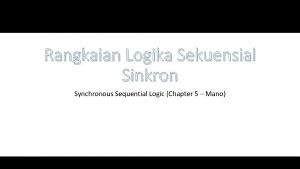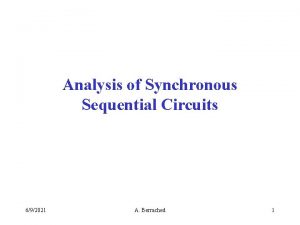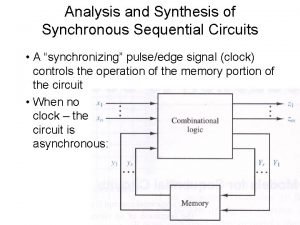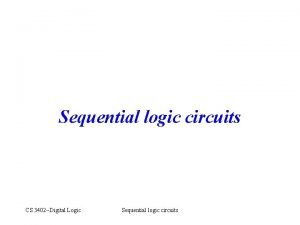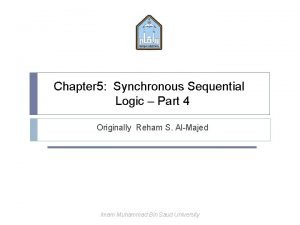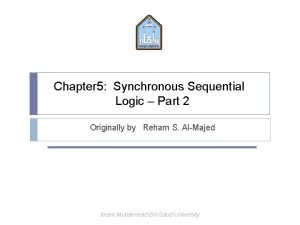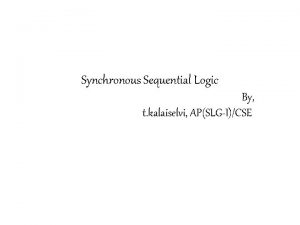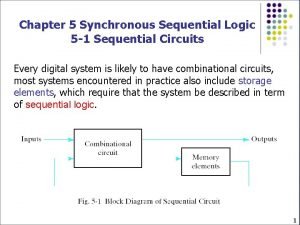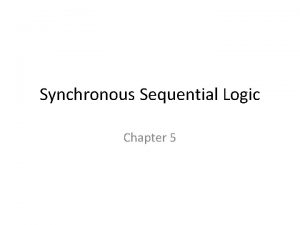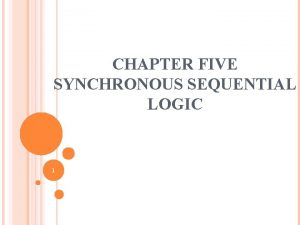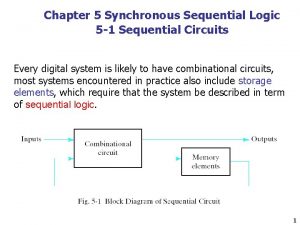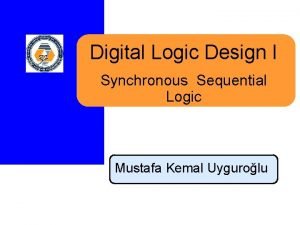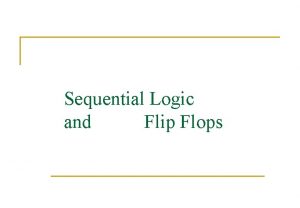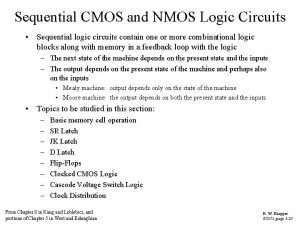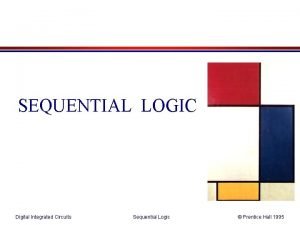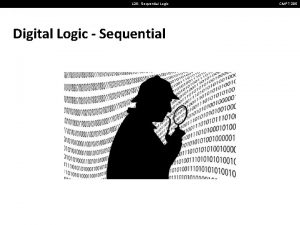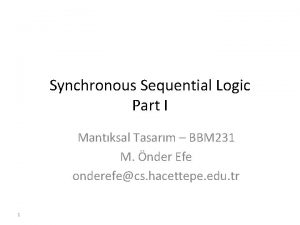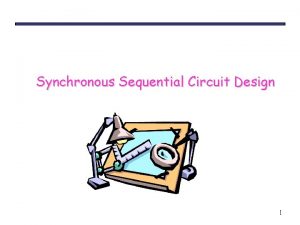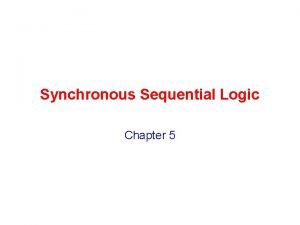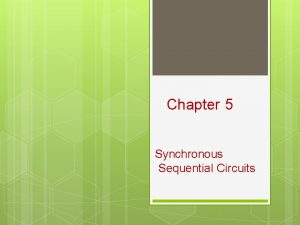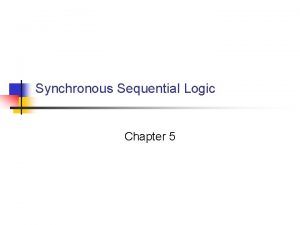Chapter 5 Synchronous Sequential Logic Part 3 Originally
































- Slides: 32

Chapter 5: Synchronous Sequential Logic – Part 3 Originally Wafa Alrajhi Imam Muhammad Bin Saud University

Outline q State reduction. q State assignment. q Design procedure Design with D FF. � Design with JK FF. � Design with T FF. � 2

State Reduction Ø This section discusses certain properties of sequential circuits that may be used to reduce the number of gates and flip-flops during the design Ø State reduction: The reduction of the number of flip-flops in a sequential circuit is referred to as the state-reduction problem Ø State-reduction algorithms are concerned with procedures for reducing the number of states in a state table, while keeping the external input-output requirements unchanged 3

State Reduction (Cont. ) Ø We explain with a sequential circuit whose state diagram is given in the next slide Ø Here, only input-output sequence is important, not the internal states Ø The states are denoted by letters 4

State Reduction (Cont. ) Ø Consider the input sequence 01010110100 starting from the initial state a Ø With the circuit in initial state a, an input of 0 produces an output of 0 and the circuit remains in state a In state a with input of 1, the output is 0 and the next state is b. Ø With present state b with input of 0, the output is 0 and the next state is c, Ø Continue… Ø 5

State Reduction (Cont. ) q Consider the input sequence 01010110100 starting from the initial state a. 6

State Reduction (Cont. ) Ø State reduction means to reduce the number of states in a sequential circuit with an identical input-output relationship Ø The easiest way of state reduction is through state table as follows: 7

State Reduction (Cont. ) Ø Algorithm: Two states are equivalent if for identical inputs they give exactly the same output and result in a transition to the same state (or an equivalent state). Ø If two states are equivalent, one of them can be removed without changing the input-output operation of the circuit. Ø We have to find a pair of equivalent states and delete one. Ø States g and e are equivalent and we can delete g and replace it with e. 8

State Reduction (Cont. ) Ø Reducing the state table is shown below: Ø Now we can see that d and f also have similar rows associated with them. 9

State Reduction (Cont. ) Ø State f can be removed and replaced by d Ø Reduced state table is shown below: 10

State Reduction (Cont. ) Ø Reducing the number of states does not necessarily mean a circuit with fewer gates and/or flip-flops. Ø Note that state reduction in general may lead to a circuit with more gates than the original system (for the combinational circuit which provides inputs to the flip-flops) Ø For the above reduced diagram and the input sequence that was given before, we have: 11

State Reduction (Cont. ) 12

State Reduction (Cont. ) 13

State Assignment Ø In order to design a sequential circuit with physical components, it is necessary to assign coded binary values to the states Ø For a circuit with m states, the codes must contain n bits where 2 n >=m. Ø For example, with three bits it is possible to assign codes to eight states denoted by binary numbers 000 to 111 Ø Whatever state table is used, first states are assigned sequentially, remaining states are kept unused (don’t care conditions) 14

State Assignment q Three possible binary state assignments 15

State Assignment q Using binary assignment 1, the previous simplified state table will be: 16

Design Procedure q It specifies the hardware that will implement a desired behavior. q Given: � q Set of specifications. Goal: � Find logic diagram. � q Input and output equations provide the necessary information to draw the logic diagram of SC. Steps: 1. 2. 3. 4. 5. Derive a state diagram from the word description. Obtain the binary-coded state table. Choose the type of FF to be used. Derive the simplified FF input equations and output equations. Draw the logic diagram. 17

Example q Design a sequential circuit that detect a sequence of three or more consecutive ones in a string of bits coming through an input line. Use D FF. 1. q Derive state diagram from specification 0 0 00/0 0 0 11/1 1 01/0 1 1 10/0 1

Design with D FF 2. 3. Obtain the binary coded state table. Choose type of FF 19

Design with D FF 4. Derive the simplified FF input equations. 20

Design with D FF 5. Draw logic diagram. 21

Excitation Table Ø Design with other types of flip-flops is not straightforward as the next state cannot directly be related to the input equations Ø In such cases we should use excitation tables, which list the required input for a given change of state Ø Next slide shows excitation tables for JK & T Flip-Flops Ø The symbol X represents a don’t care condition 22

Excitation Table (Cont. ) 23

Excitation Table (Cont. ) q Consider the sequential circuit given by the following table: 24

Design with JK FF Ø Assume that it is desired to design this sequential circuit using JK flip-flops Ø Using excitation table of JK FF, we have: 25

Design with JK FF (Cont. ) 26

Design with JK FF (Cont. ) q The logic diagram can be obtained from the input equations given above 27

Design with T FF Ø Example: Consider a 3 -bit binary counter shown in the diagram: Ø In fact the only input to the circuit is the clock and the output is the present state of the flip-flops. 28

Design with T FF q The state table for this example is as follows: 29

Design with T FF q The most efficient way to construct a binary counter is by using T flip-flops, because of their complement property. 30

Design with T FF q Logic diagram of the counter: 31

Reading q 5. 1 q 5. 2 q 5. 3 q 5. 4 q 5. 5 q 5. 8 32
 Combinational vs sequential logic
Combinational vs sequential logic Software project wbs example
Software project wbs example Majority circuit
Majority circuit Combinational logic sequential logic 차이
Combinational logic sequential logic 차이 Logic chapter three
Logic chapter three Rangkaian logika sekuensial
Rangkaian logika sekuensial Jelaskan pengertian dari synchronous sequential system
Jelaskan pengertian dari synchronous sequential system Analysis of synchronous sequential circuits
Analysis of synchronous sequential circuits Analysis of synchronous sequential circuits
Analysis of synchronous sequential circuits What is project duration
What is project duration What is a nonserual sequential logic in project
What is a nonserual sequential logic in project Programmable logic devices in vlsi
Programmable logic devices in vlsi S r q logic gate
S r q logic gate First order logic vs propositional logic
First order logic vs propositional logic First order logic vs propositional logic
First order logic vs propositional logic First order logic vs propositional logic
First order logic vs propositional logic Tw
Tw What was the game of volleyball originally called
What was the game of volleyball originally called Unix was originally developed in
Unix was originally developed in A whalebone that originally contained 200 grams
A whalebone that originally contained 200 grams Originally carol ann duffy analysis
Originally carol ann duffy analysis Duffy originally
Duffy originally Invention of play doh
Invention of play doh Medusa carol ann duffy genius
Medusa carol ann duffy genius A biologist originally marked 40 butterflies
A biologist originally marked 40 butterflies Define primate city
Define primate city Manmeet gill
Manmeet gill A piece of copper originally 305mm long
A piece of copper originally 305mm long Where do bananas originally come from
Where do bananas originally come from Even though beowulf was originally dgp
Even though beowulf was originally dgp Why was the gps network originally developed
Why was the gps network originally developed The most widely used agile process originally proposed by
The most widely used agile process originally proposed by How was the coffee maker originally made
How was the coffee maker originally made






